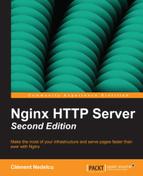Book Description
Nginx can be an ideal replacement or supplement to Apache. Learn just how straightforward it can be to embrace the Nginx alternative and run a server designed 100% for today’s web using this brilliant tutorial.
- Complete configuration directive and module reference
- Discover possible interactions between Nginx and Apache to get the best of both worlds
- Learn to configure your servers and virtual hosts efficiently
- Discover possible interactions between Nginx and Apache to get the best of both worlds
- A step-by-step guide to switching from Apache to Nginx
In Detail
Nginx is a lightweight HTTP server designed for high-traffic websites, with network scalability as the primary objective. With the advent of high speed Internet access, short loading times and fast transfer rates have become a necessity. This free, open source solution will either come as a full replacement of other software such as Apache, or stand in front of your existing infrastructure to improve its overall speed.
"Nginx HTTP Server Second Edition" provides a detailed guide to setting up Nginx in different ways that correspond to actual production situations: as a standalone server, as a reverse proxy, interacting with applications via FastCGI and more. In addition, the complete directive reference will be your best friend at all stages of the configuration and maintenance processes.
This book is the perfect companion for both Nginx beginners and experienced administrators. For beginners, it will take you through the complete process of setting up this lightweight HTTP server on your system and configuring its various modules to get it to do exactly what you need, in a fast and secure way. For more experienced administrators, this book provides different angles of approach that can help you make the most of your current infrastructure. Nginx can be employed in many situations, whether you are looking to construct an entirely new web-serving architecture or simply want to integrate an efficient tool to optimize your site loading speeds.
This book takes you through the setup and configuration of Nginx by detailing every step of the way, from downloading to configuring your server in a selection of common architectures.
Table of Contents
- Nginx HTTP Server - Second Edition
- Table of Contents
- Nginx HTTP Server - Second Edition
- Credits
- About the Author
- About the Reviewers
- www.PacktPub.com
- Preface
- 1. Downloading and Installing Nginx
- 2. Basic Nginx Configuration
- 3. HTTP Configuration
- HTTP Core module
- Module directives
- Socket and host configuration
- Paths and documents
- Client requests
- keepalive_requests
- keepalive_timeout
- keepalive_disable
- send_timeout
- client_body_in_file_only
- client_body_in_single_buffer
- client_body_buffer_size
- client_body_temp_path
- client_body_timeout
- client_header_buffer_size
- client_header_timeout
- client_max_body_size
- large_client_header_buffers
- lingering_time
- lingering_timeout
- lingering_close
- ignore_invalid_headers
- chunked_transfer_encoding
- max_ranges
- MIME types
- Limits and restrictions
- File processing and caching
- Other directives
- Module variables
- The Location block
- Summary
- 4. Module Configuration
- Rewrite module
- SSI module
- Additional modules
- Summary
- 5. PHP and Python with Nginx
- 6. Apache and Nginx Together
- 7. From Apache to Nginx
- A. Directive Index
- B. Module Reference
- Access
- Addition*
- Auth_basic module
- Autoindex
- Browser
- Charset
- Core
- DAV*
- Degradation*
- Empty GIF
- Events
- FastCGI
- FLV*
- Geo
- Geo IP*
- Google-perftools*
- Gzip
- Gzip Static*
- Headers
- HTTP Core
- Image Filter*
- Index
- Limit Conn
- Limit Requests
- Log
- Map
- Memcached
- MP4*
- Proxy
- Random index*
- Real IP*
- Referer
- Rewrite
- SCGI
- Secure Link*
- Split Clients
- SSI
- SSL*
- Stub status*
- Substitution*
- Upstream
- User ID
- uWSGI
- XSLT*
- C. Troubleshooting
- Index
